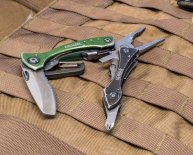
Short Katana Sword
What were the military and symbolic significance of the long and short sword?
The sword was the most honored and important weapon for samurai. When a samurai was born, a sword was brought into the room; when he died, a sword was laid beside him, and in between those two events a samurai always slept with his sword by his pillow. Constantly at his side, it was a symbol of the warrior’s physical strength, discipline, and loyalty. Its razor-sharp edge was a point of pride for warriors, allowing for quick, precise cuts and thrusts in the chaos of battle.
How were they made?
Sword making is a highly refined and respected art in Japan, part of a ritualized process requiring decades of training. To make a sword, the smith heated blocks of steel, hammering, folding, cutting, forging, and re-forging to drive out impurities and create a finely layered blade that was hard but not brittle. The folding-in of softer iron near the end of the process added resiliency, while the final tempering of the blade, which exposed the edge to the greatest heat and fastest cooling, created an exceptionally hard cutting edge. After the sword-smith had completed the blade, a grinder and polisher gave it its gleaming finish, exposing the unique structure of its razor-sharp edge.
How did sword styles change to meet the needs of the warrior?
The use of single-edge iron swords (tachi), dates to the sixth century. By the Kamakura era (1185–1333), tachi were being used by mounted warriors, and rivaled the bow and arrow in importance to the samurai. To improve the tachi’s capability as a cutting and slashing weapon, its design was gradually altered. The long blades became tapered from the hilt to the tip; they were ridged for greater strength; and were curved slightly at the base. To better serve the needs of foot soldiers, a shorter sword (katana), was developed. Curved at the tip and worn stuck into the belt (cutting edge up), the katana allowed soldiers to move unencumbered, able to draw and cut in one stroke.
In the fifteenth century, mounted samurai also came to prefer the katana, since they often dismounted for hand-to-hand combat. An even shorter companion sword called the wakizashi soon joined the katana in the samurai’s arsenal. Worn together, the pair was known as daisho (big and little).
What is the significance of the sword’s decorative fittings?
During the peacetime years of the Edo period (1615–1868), the daisho became a mark of status for the samurai, the only members of society allowed to wear two swords. As the sword became more symbolic than functional, the quality of the blades declined, but enthusiasm for elaborate and expensive sword fittings grew. Sword owners would own many sets of fittings, changing them to suit the occasion or season. Although elegant fittings had been made earlier, the art form reached its peak in the Edo period with richly inlaid and sculpted scenes, and patterns combining precious metals and new alloys.


















